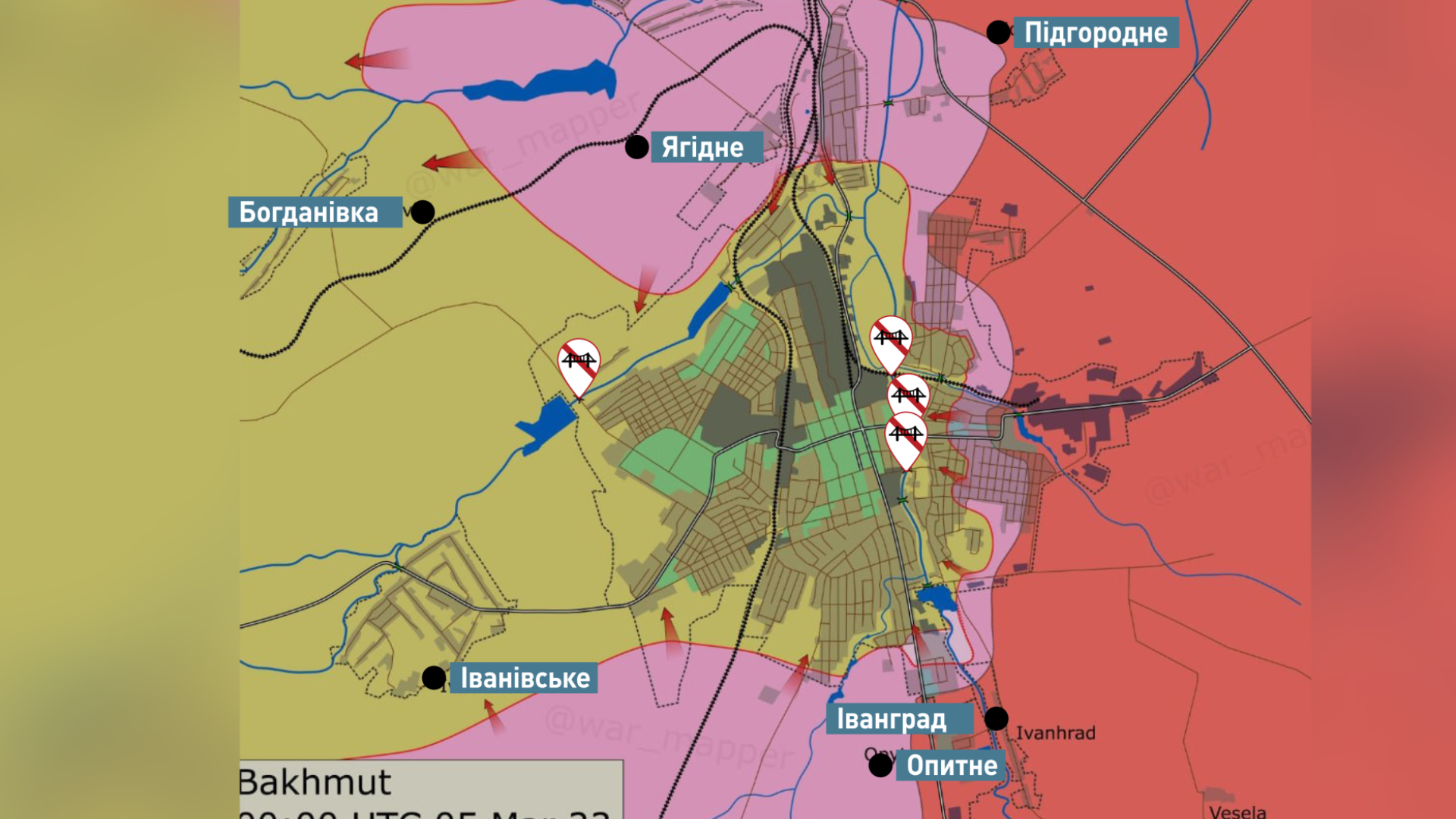
Russia shells important routes leading to Bakhmut, but Ukrainian Armed Forces control the city. Military expert Serhiy Zgurets
Important roads to Bakhmut are under Russian fire, but Ukrainian troops control the city and launch counterattacks
The situation near Bakhmut
So, Bakhmut. The Ukrainian defense of Bakhmut is under increasing enemy pressure. Intense fighting is taking place in and around the city, but Ukrainian troops are not withdrawing. Even after the capture of Soledar (which was one of the towns on the Siversk-Soledar-Bakhmut defense line), the fortress is still being held. Russia has been unable to capture Bakhmut for more than 9 months, and now it is attacking the city from 3 directions. In addition to the east, Russian troops are attacking the flank of Bakhmut on both roads. In the south, it is Kostyantynivka - Bakhmut road: there are ongoing battles there, in particular, near the village of Ivanivske. In the north, Russian troops are attacking in the direction of Khromove, Berkhivka, on the road from Chasiv Yar. These important roads to the city are under Russian fire, but not cut off. The city is controlled by the Ukrainian Defense Forces: the Ukrainian Armed Forces, the State Border Guard Service, the National Guard, and the troops of the Territorial Defense Forces. Despite Russia’s constant pressure, Ukrainian military are taking measures to stabilize the front line, including by launching counterattacks in certain areas. The resistance is so steady, Russia’s losses are so great that it is whimpering. Prigozhyn, Wagner PMC founder, claims that if Wagner mercenaries retreat from Bakhmut, the entire frontline will move to the Russian border or even further.
A soldier of the 204th Battalion of the Ukrainian Armed Forces, call sign Kyianyn, said that recently Russian attacks near Bakhmut have become more severe, more massive, and the use of artillery and aviation has increased, as if Russia needs to capture Bakhmut at any cost, destroying it to the ground and driving Ukrainian troops out. The situation is indeed difficult, but the Ukrainian units that remain there (caliber infantry, heavy brigades, National Guard, Special Operations Forces, aerial reconnaissance, artillery) have been there for a long time, know the area, have their own marked points and have been holding the line for a long time, so even if Russian troops are advancing, their advance is not significant. According to Kyianyn, a powerful assault brigade is operating in the area of Klishchiivka. They have trained for these actions specifically. Wagner mercenaries and Russian paratroopers are having a hard time. When Ukrainian troops launch the offensive, they will fully experience the unrestrained power of Ukrainian fighters. In this war, despite all the technological weapons, it is the infantry that wins. Our engineering and sapper units are always working.

There is a crossing, equipment, and means to maneuver units and not to accumulate troops. There are problems, but the logistics are working. Blowing up a bridge is always a preventive action when there are specific threats. These commands are given by the top military leadership, so all of it is logical. As for the intensity of cannon, rocket artillery, and air strikes, it seems that Russian troops are not running out of ammunition. On the positive side, Ukrainian artillery is also working hard. The famous 93rd Brigade is fighting in the eastern part of Bakhmut. The battles are close, but their courage keeps everything going. The armor helps, the tankers are great. Wagner mercenaries were saying they had no ammunition and no help. These lies are an excuse for the fact that they were driven out of Bakhmut and Soledar by 70 to 80%. They had an agreement with Putin that they would capture Bakhmut, but nothing happened. They need to justify themselves, and they start using the narrative that they have been deprived of ammunition and of access to convicts. The population in Bakhmut is differentiated. There are very pro-Ukrainian people, patriots. There is the largest category of the population that is waiting to see what will happen. Now there are conditions for the withdrawal of troops from Bakhmut. The logistics are in place and working. The military leadership is aware of everything and is taking counter-attack actions aimed at expanding the corridor. Ukrainian defenders are launching assault operations and know their responsibilities.
The request to the EU to provide more ammunition
Indeed, Ukrainian troops have conducted successful counteroffensives in the direction of Klishchiivka, gaining a foothold with the support of artillery and aviation. In the days ahead, Ukraine will expand the security corridor that is important to it, using all means at its disposal. On the other hand, the Ukrainian Armed Forces still need artillery and ammunition in this area of the frontline and in other areas. Ukraine has asked the EU to send 250,000 artillery rounds per month to reduce the shortage that is limiting the progress of the Ukrainian Armed Forces on the battlefield. This, in particular, is stated in a letter from Ukraine’s Defense Minister Oleksii Reznikov to his counterparts in the EU and the EU High Representative for Foreign Affairs. It was announced yesterday. Currently, according to the Defense Minister, the Armed Forces of Ukraine fire an average of 100,000 155 mm caliber shells per month fighting Russian troops, but this is only a quarter of the amount used by Russia. In total, Ukraine received about 2 million shells from its partners, but the US and its stockpiles played a major role. The whole of Europe produced only 300,000 shells last year. In total, there are 12 manufacturers. France, for example, produces only 20,000 shells a year. Now the EU is increasing the production of ammunition to support Ukraine. In particular, last month Estonia proposed that the EU allocate EUR 4 billion to purchase 1 million shells from various manufacturers for the Ukrainian Armed Forces. There is a less ambitious plan from the EU to allocate EUR 1 billion over the next few months so that European countries can use the money to compensate for ammunition from their stockpiles and launch joint production in the near future. How the EU will accelerate the accumulation of ammunition for Ukraine will be discussed at the March 23 summit in Brussels. The situation on the front line depends on ammunition, and it will be especially important when Ukraine launches a counteroffensive.
Construction of a tank factory in Ukraine
In addition to artillery and ammunition, Ukraine needs tanks and heavy armored vehicles. We expect Leopards of various versions, Challengers, Abrams to form new brigades and corps. The first Leopards from Poland are already in Ukraine. Against this backdrop, new initiatives have been announced that may seem premature at first glance, but it depends on how you look at it. The European consortium Rheinmetall is negotiating with Ukraine to build a new tank plant. The company's CEO said that the talks are promising and that the consortium leaders hope to make a decision within 2 months. Construction of the plant is estimated at EUR 200 million. It will be able to produce up to 400 main battle tanks of the new Panther type per year, i.e. 33 vehicles per month, or one per day. According to the head of Rheinmetall, production should start quickly and Ukraine needs at least 600 to 800 tanks. The head of Rheinmetall believes that even if Germany delivers all the Leopards, it will not be enough for an effective offensive and security of Ukraine. This is a tank that has only one prototype and differs from the Leopard in a new turret with a 130 mm gun. The gun has twice the power and range of a direct shot. Whether the plant will be built is a matter of perspective, but it is good that the question of building it is being raised. Rheinmetall understands that the Ukrainian Armed Forces will be re-equipped. If Leopards are indeed going to be the main tanks, they will need to be repaired and modernized, including a new digital turret. Ukraine needs to use this potential properly, create conditions for good investment and maximize the involvement of its enterprises. Such projects seem premature, but if we had thought about it a little earlier, we would have had fewer issues on the battlefield.
- News














































